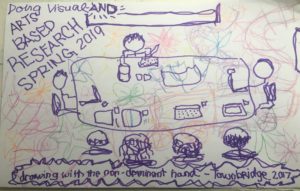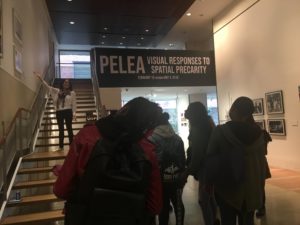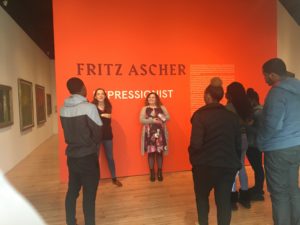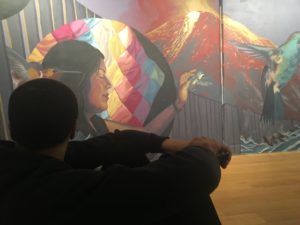Author Archives: Noor
Rainy Sunday Left Hand Drawing
It is a rainy Sunday morning and I chose to try out drawing with the non-dominant hand mindfulness activity from the Townsend piece. It was my first instinct upon reading as I was also asking myself, “when was the last time I drew with my left hand?” The activity proved to be calming and also very amusing as I tried to recreate our class. As you can see my memory is less on the specific but more the overall situation. The table and the wine bottle were the first on the page. While drawing, I was wondering if our fluid experiences in the class (sharing space) can act as a sort of diorama? I was also thinking about Lamar’s post throughout, (I am sending prayers out to you and your students and their families) which also connects to the part of the piece were she writes how teachers are seeking “refuge from the realities of the public schools”. It is powerful that so many folks were trained on mindfulness but I also wonder when funds and policies will go to support communities and families to improve the quality of life for targeted populations? It reflects a real tension I have with mindfulness as a band-aid and in some ways making stress an individual issue versus something that is structurally imposed historically for specific populations. I also know how important it is to build up our toolkit of practices to individually process and heal. I am curious about the power of carving out spaces of refuge for people facing intersectional oppressions – where refuge is denied systematically and what are our next steps in our roles working with diverse populations along various levels of power? I wonder about the feeling of freedom dreams and what they can teach us about the importance of an imaginary refuge in the process towards liberatory actions that meet the realities faced by targeted populations. Given that some public schools are differently and similarly violent, to all the people who inhabit them and particularly burdensome on the youngest and most vulnerable, how might we draw upon art based practices to make shifts on a structural and individual level?
This piece also offered a way for me to think about the different levels of decision making necessary for building a space of learning with diverse perspectives and experiences. She offers the following capabilities;; 1) focusing attention on what is happening in the classroom 2) questioning what is happening in their own emotions 3) teaching objectives reflect students’ needs, 4)questioning what behaviors teachers choose to achieve their objectives. (180) I see these as all a part of intention setting on an individual level but really a good model for structuring school as a collective staff and student community. What if each person drew out their answers to these questions – taking away the element of power and having each person reflect on what they need to learn in a highly oppressive society/school system?
A few powerful quotes:
“In looking at the diorama, with its focus on phenomena of the natural world, the viewer is looking and thinking, and is in the position of the discoverer, rather than the a passive recipient of knowledge transmitted by others.” How does this shift when moving from the natural world to an unnatural public school structure? In this way, does drawing offer us a form of praxis that is not available just through verbal dialogue?
“objects and words can be generative” – Freire
“mindful learning is the continuous creation of categories, openness, to new information, and an implicit awareness of more than one perspective.” Do drawings also offer color, detail emphasis, ways of seeing of the creator?
“drawing is at the root of everything’ – Van Gogh
“Seeing comes before words” – John Berger. Will freedom dreams and art offer us new words to curve liberatory life/educational experiences?

Then I started listening to music – this came on as I was about to post so I will share:
Wonderings on process – art making, dialogue and experiences




I enjoyed the readings for this week and they provided a powerful through line to my interest in collage and the relational and affective process of making art and narrating intergenerational experiences of black women and girls. Reading the article on photovoice and the collaging of young pregnant women left me wondering what it would like to place those processes in dialogue with each other for my class project? What if the girls and women took photos of their worlds while inserting the imaginary, natural, media images? How might this shift the dialogue in the space and on the paper? While thinking of the origin of photography and bodies specifically in the historical lives of black women and girls, I think of photos as violent exploitation, specifically pornographic voyeurism of white male social scientists. Further, I am reminded of Sara Baartman, and how black women and girl’s bodies were placed on display for inspection, exploitation and economic gain. I am brought back to this when thinking of the “immense danger associated with changing bodies and blossoming female sexuality” (54) and Anne Cheng’s assertion that “we don’t know enough about how racialized people as complex psychical beings deal with the objecthood thrust upon them…within the reductive notion of “internalization” lies a world of relations that is as much about surviving grief as embodying it.”(20) I wonder about this as I read the dialogue of the girls as they focus in and question each other’s physical characteristics and representation at various levels. I wonder about the interplay of time space in collaborative seeing? I wonder about how “the complex evocation of the children’s images and their context-dependent meaning can be preserved” within a photo, conversation, in the emotive registers and “embodied practices” (182) in the process of viewing and creating within intersectional black girlhoods? In this, I am also drawn to the “unknown girl.” I am curious about taking a critical bifocal lens and asking what part of her being unknown and thus separating herself is also a matter of social scientific research machine (Moynihan and others) that profits from the invention of a blackness and femaleness that represents and creates pathologies of poverty, pregnancy and violence while silencing the broader experience of poor white Americans? How white hegemony continues to obscure the material realities of generations of poor white folks and is also complicit in differing forms of racial exclusion inside and out of schools?
I also was thinking about how my own collage processing, where my human shape is never present but always reflected in a flow of ideas, colors and words. These readings also spoke to my role as an educator, who employs collage work regularly, and had me pause on the importance of prompts in art making. I am drawn back to Carol Gilligan’s push on the importance of offering an interviewee a real question, that is simple in its humanity and from a deeply mined place. A prompt must hold such complex simplicity as they provide a landscape for a certain type of exploration. I would love to learn more about the development of prompts for art-based research. For example, I am processing what it means to create a self-portrait versus a prompt to build a collage where you ask who am I? I loved the critical approach to collage making and centering the psychological associative logic that offers several pathways to interpretation and reinterpretation. I continued to think about the balance of being “glamourous” and that of a social justice art-based researcher and the constant anxieties that are produced in the process of trying to intercept hegemony, socially and psychologically and also create a space to be respected and safe. I appreciated how Luttrell weaves in her own narrative and emotionality in the process alongside the students. I am curious about, moments that she didn’t share in the article. If so, what were the other moments and how did she make the choice as to what to include? I am reminded of Kaela’s decision to paste a bright sun over her visit to the store. Where she clips and adjust her experience and what will be told in a purposeful manner. I was most blown away by the power of reading and viewing the teen’s reflexivity, curiosity and chatter as a heuristic for dialogic research processes. It is not the final result but the learning and growing that holds my attention throughout. I see this also reflected in Luttrell’s language, while sharing openly that much has changed in her own research over time and I also notice how the writing leaves gaps for curiosity and questioning. I appreciated the critical attention to power in the lives of children/people in the process of research and how tools, photography in this case, no matter how well intentioned is complicit in various forms of oppression. In response, I saw Luttrell speak back against simple first impressions and research that stand to further misrepresent the children, young women and families just as we saw Gabriel and Kendra share counter narratives in their photovoice projects.
I was also drawn to the “emotional landscapes” and the children’s and teen’s desire for “comfort, sense of belonging and respect”. I am curious about how Luttrell built her art research space? What did it look like? What sensory dynamics were important for her? I noted the use of “contraband” light music upon the young women’s request. This process of “homeplace” making called me to reflect on last Friday where I took my students on visual tour of three different spaces at NYU, one specifically on spatial precarity and another on sanctuary. PELEA: Visual Responses to Spatial Precarity https://wp.nyu.edu/latinxproject/event/pelea-visual-responses-to-spatial-precarity/, We Imagine Sanctuary: A Mural and Sound Installation http://apa.nyu.edu/we-imagine-sanctuary-a-mural-and-sound-installation-monday-february-25-friday-may-10-2019/ and Fritz Ascher: expressionist| Metamorphoses: Ovid Accoring to Wally Reinhardt https://greyartgallery.nyu.edu/exhibition/fritz-ascher-and-wally-reinhardt/
The youth’s emotive responses in each space were powerful and very diverse. PELEA students had a sense of feeling welcomed by the curator artist, warm feelings of familiarity, curiosity of whether racism was happening, beauty, nervous laughter and silence. The Sanctuary space slowed our pace, as we heard the audio recording share that “home is where my mother is” and other dreams and critical push towards survival in highly oppressed social positions. We sat in relaxed positions on the ground in the dimly lit space and named the place a sanctuary and wrote different ideas of peace “felt like grass with no wind. Just sun.” Students asked about the cost and the originality of a painting in the Fritz Ascher gallery. One student recently migrating from Chicago reinterpreted his expressionist flowers as explosions. Another poured over a book of poetry on a chair and another took a picture next to a sunset with a smile, stating this was her favorite. I am still processing the experience – as a sensory editing and remaking of visual art space – that takes on a sensory and dialogic component.
PELEA: Visual Responses to Precarity – Free Event
https://wp.nyu.edu/latinxproject/event/pelea-visual-responses-to-spatial-precarity/
The Dynamics of Researching With – Noor Jones-Bey
“If you have come to help me, then you are wasting your time . But if you have come because your destiny is bound up with mine, then let us work together.” – Australian Aboriginal Woman
Sarah Pink writes, “The practice of sensory ethnography involves the researchers’ empathetic engagement with the practices and places that are important to the people participating in the research. And by association it does not therefore principally involve the collection of data about them that can later be analyzed. Rather it involves the production of meaning in participation with them through a shared activity in a shared place.” In this passage the author offers a way to produce knowledge that recognizes that knowledge production is a multi-sensory experience made with and among people. Traditional ethnographers, like Geertz, provided a method which asks for a researcher to collect data, a process that indirectly and directly places a one way relationship between people and therefore, the roles participant and researcher, where the researcher extracts from the experience of the participant in order to understand their actions and life ways. The turn that Sara Pink offers asks for research to expand toward the embodied theory and practices of Theaster Gates and Matta Clark. Pink’s sensorial ethnographic approach begins by engaging in relationship with people as they conduct their lives as a means to understand their full experiences and life ways. She writes, “In ethnography, interviews might range from the form of a more casual conversation to sitting down with an audio recorder to discuss specific issues in a focused way. Whatever the context, I understand the interview less as a data collecting exercise than as a shared conversation through which new ways of knowing are produced.” These moves reflect on what everyday and theoretical decisions are necessary to shift the traditional approaches of social science research practices toward more humanistic and relational methods that ask for people to work together non-hierarchically to build knowledge and learn from one another.
In terms of Sensory Ethnography, Sarah Pink offers, “By asking a research participant to guide one around a particular locality (in my work this has included homes, a garden and a town) that holds meaning for him/her, and in which he/ she is engaged practically on a regular basis, enables the researcher to move through and be in and part of an environment with the participant. When viewing the subsequent video recording the researcher is thus re-experiencing a route through a material, sensory and meaningful world, as already seen through the viewfinder. This is rather different from the perspective of looking at and reading from video-as-data from which cultural meanings can be interpreted/read.” In this way, Sarah Pink shows how necessary it is for researchers to become fully immersed in the sensorial experience which calls for a deeper connection to the various meaning that are produced across the lifeways of individuals she is learning from. Thus researcher’s are asked to call on their own embodied experiences with the research participant, which is asks for a level of self reflexivity in the analytical process. Matta Clark was successful in building art spaces, like Food, that became hubs for social life but wasn’t able to address social inequality in the sustained ways Theater Gates has in Chicago. I wonder what this means for research that isn’t interested in just producing theory but aims to support action and social change. Is there a certain rootedness and commitment that is necessary for social change research, whether that is art based or not? What possibilities are visible for Theaster Gates as a artist, designer, developer, researcher who grew, learned and worked with the same community for 20 years versus a visiting artist developing an art center? What relationships (within and outside of the community) were at the foundation of his work and create a fertile ground for sustainable art based social change methods?
What does the reader take away? Noor Jones-Bey’s Response
Eisner writes, “Visual arts are used to communicate the way something feels, that is, its emotional character.” As I was reading this week, I couldn’t help but think about visual arts based research is a form of humanization that flows back and forth through the researcher and the work, in the case of Eisner who allowed his deep love of art to take over the strict training at the University of Chicago. It makes me think of the large growth of Ivy on a building in Berkeley many years ago. The Ivy made a home in every wall of a building, until the paint and original structure became obscured by years of natural growth. These readings ask us to explore what may be possible, if we allow ourselves to grow beyond the structured design of our own methodological programming. Further, all of the readings address the emotionality which allows the researcher but also those who read the research to be partners, through what Dewey offers as slowing “down perception and invit(ing) exploration” among all people. What is the purpose of static knowledge, if we are in a world that is expansive and ever changing? Like the Ivy plant, what we know can be reduced with sheers or statistical analysis but what of the possibilities when we allow ourselves and the research to flow out and over the tools made for reduction? What is possible when we research with the purpose of creation? Where is it necessary to reduce and in what ways is this harmful to what we come to know as truth or “fact” thinking of Barone, who writes, that facts are not adequate for telling the whole story?
I really loved thinking of arts based research and methodology as a heuristic and would love to explore how different researchers have done this work. I agree with Eisner and Barone who write that “the borders between art and science are malleable and porous” and further, see how Western society has yet to tap into the potential of interdisciplinary pluralist research. These readings made me think of Sylvia Wynter’s piece, The Sociogenic Principle, which examines how the division between science and art leave major gaps in knowledge. She writes advocating for a deepening of understanding of poetic knowledge as a means to understand all that is not known within “hard sciences” like physics and chemistry, etc. Why is the western conception of science devoid of humanity? I loved how the authors included their personal narratives or what Carol Gilligan might call the roots of their work, and also offer simple and profound questions for researchers. Some that are sitting with me currently include, “what does the reader take away?” What is the impact of the tools we use on our research but also on ourselves? How does feeling and expression shape our understanding of a person, place or situation? How might we as researchers and educators touch the souls of students as well as measure their sleeve or hat size? How can our research address help readers to learn and notice aspects of the world and further debate or dialogue with another?


